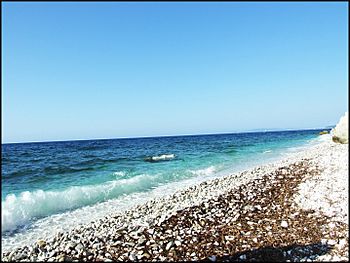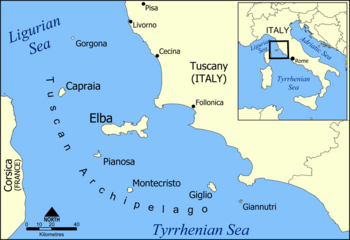Tuscan Archipelago facts for kids

|
|
 |
|
| Geography | |
|---|---|
| Location | between Ligurian Sea and Tyrrhenian Sea |
| Archipelago | Tuscan Archipelago |
| Administration | |
|
Italy
|
|
| Demographics | |
| Population | 31 875 |
The Tuscan Archipelago is a group of seven beautiful islands located off the coast of Tuscany, Italy. These islands are found in the waters between the Ligurian Sea and the Tyrrhenian Sea.
All seven islands are part of the Tuscan Archipelago National Park. This park helps protect their amazing nature and wildlife.
Contents
Discovering the Tuscan Archipelago
The Tuscan Archipelago is made up of seven main islands. Each island has its own unique features and history. Together, they cover an area of about 295 square kilometers.
The tallest point in the archipelago is Monte Capanne on Elba island. It reaches 1,018 meters (3,340 feet) high. About 31,875 people live across these islands.
The Seven Islands
Here is a quick look at the main islands in the Tuscan Archipelago:
| Island | Size (km²) | Population |
|---|---|---|
| Elba | 224 | 30,000 |
| Pianosa | 10 | 0 |
| Capraia | 19 | 366 |
| Montecristo | 13 | 0 |
| Giglio | 24 | 1,553 |
| Gorgona | 2 | 220 |
| Giannutri | 3 | 102 |
| Total: | 295 km² | 31,875 |
Elba: The Largest Island
Elba is the biggest island in the group. It is famous for its beautiful beaches and clear waters. Many people visit Elba for swimming, diving, and hiking.
Elba is also known for its history. The French emperor Napoleon was exiled here in 1814. You can still visit his house in Portoferraio, the largest town on the island.
Pianosa: The Flat Island
Pianosa means "flat" in Italian, and this island is indeed very flat. It has no permanent residents today. It was once used as a prison.
Because it was a prison island for a long time, its natural environment is very well preserved. Visitors can only go to certain parts of the island.
Capraia: The Volcanic Island
Capraia is the only island in the archipelago that was formed by volcanoes. It has a rugged coastline and beautiful coves. The island is home to a small village and a historic fort.
Montecristo: The Mysterious Island
Montecristo is a wild and uninhabited island. It is very famous because it is featured in the book The Count of Monte Cristo by Alexandre Dumas. The island is a strict nature reserve.
Only a very small number of visitors are allowed each year. This helps protect its unique plants and animals.
Giglio: The Lily Island
Giglio island is known for its charming villages and lovely beaches. Its name means "lily" in Italian. The island has a medieval castle and ancient Roman ruins.
It is a popular spot for tourists who enjoy its clear waters and relaxed atmosphere.
Gorgona: The Prison Island
Gorgona is the smallest island in the archipelago. It is home to an active prison. The prisoners work on farms and vineyards on the island.
Because of the prison, public access to Gorgona is very limited. This helps protect its natural beauty.
Giannutri: The Crescent Island
Giannutri is a small, crescent-shaped island. It is known for its ancient Roman ruins, especially the remains of a large villa. The island has beautiful clear waters perfect for snorkeling.
It is a quiet island with few inhabitants.
A Protected Paradise
The entire Tuscan Archipelago is a national park. This means that its natural environment is carefully protected. The park helps preserve the diverse plants and animals that live here.
You can find many types of birds, including rare ones like the Audouin's gull. The waters around the islands are full of marine life, making them great for diving and snorkeling. The park also protects unique Mediterranean plants, such as the Mediterranean buckthorn.
The Tuscan Archipelago is a special place where nature and history come together. It offers amazing landscapes, clear seas, and a chance to explore unique Italian islands.
Images for kids
-
L'Enfola, Elba island
-
Napoleon's house in Portoferraio.
-
Cala Giovanna, Pianosa island
-
Capraia main village, Capraia island
-
Montecristo Island
-
Cannelle beach, Giglio island
-
Giannutri coast
-
The village of Gorgona seen from the harbour
-
Palazzo della Specola, Pianosa island
See also
 In Spanish: Archipiélago Toscano para niños
In Spanish: Archipiélago Toscano para niños
















